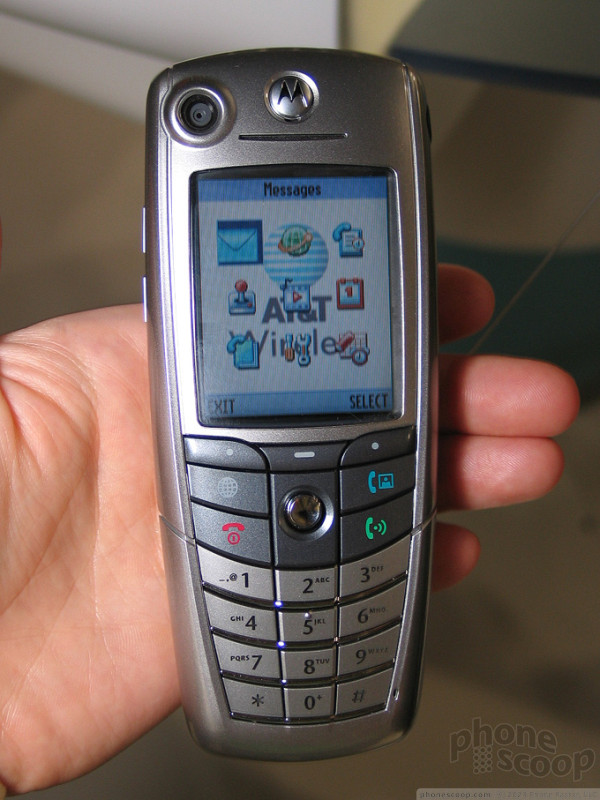CTIA Wireless 2004
Motorola announced three ground-breaking new phones at CTIA this year. All three are feature-packed, flagship-class phones, and each one includes world-first technology.
The A845 is the first WCDMA (UMTS) 3G phone in the world that works in the 1900 MHz frequency band, also known as PCS. That makes it the first phone to be announced that will operate on the new WCDMA 1900 network being built by AT&T Wireless, which is slated to launch in four cities - possibly as early as July.
The A845 is based on the A835, a WCDMA 2100 phone that has already been released overseas. The only major difference is the WCDMA frequency.
Like the A835, the A845 is also a tri-band GSM phone, supporting GSM 900, 1800, and 1900. That means it doesn't support AT&T's GSM 850 networks. The reason, according to Motorola, is simply time-to-market - changing the GSM 900 frequency to 850 would have delayed the phone at least 2-3 months.
Highlights of the A845 include dual VGA cameras, video calling (live video conferencing), MP3 player, 64 MB of memory, and Bluetooth.
Next up is the A840. Despite the similar model numbers, the A840 couldn't be more different from the A845.
The A840 is one of two new dual-technology CDMA/GSM world phones announced at the show - the other is the Samsung SCH-A790. Both phones support CDMA on North American frequencies (800/1900) and GSM on European/Asian frequencies (900/1800). For the first time, CDMA carriers will be able to offer phones that work worldwide.
Both phones have a lot in common. Both are stylish clamshell models with dual color displays, cameras, and an LED flash.
There are major differences, however. First, the A840 supports GPRS roaming, so that with proper carrier roaming agreements, features such as MMS, WAP, and even BREW will work in both CDMA and GSM modes. The Samsung only supports voice in GSM mode.
Second, the A840 sports a 1.2 megapixel camera and video recording. The Samsung's camera is VGA resolution, and doesn't do video.
Finally, the A840 has an MP3 player, and a TransFlash card slot, enabling memory expansion up to 128 MB. (TransFlash is the new name for T-Flash, which was originally called TriFlash-R. Hopefully this is the last name-change for this card format!)
The third new phone is the V710, a CDMA phone with Bluetooth. It's technically not the first CDMA Bluetooth phone, but it might as well be. The Motorola 270c supported Bluetooth, but only via a snap-on accessory. The Sony Ericsson T608 was the first CDMA phone with integrated Bluetooth, but it only saw very limited distribution.
The V710 has a lot in common with the A840, including the 1.2 megapixel camera, video recording (up to 3 minutes), speakerphone, TransFlash slot, and BREW.
Bluetooth is what makes this phone stand out, however. The V710 supports the Hands-Free, Headset, and Dial-Up Networking (DUN) profiles. Hands-free is generally for car kits, and DUN is for sharing data connections with devices like laptops and PDAs. OBEX is unfortunately not supported, meaning the phone can't easily exchange things like contacts, photos, and ringtones via Bluetooth.
Assuming carrier testing goes well, the V710 should be available around mid-year.
The E398 is another new high-end phone, announced several weeks ago. It shares many basic specs with the V600, including the great display, VGA camera, and Bluetooth. It adds several key features, however, such as a flash for the camera, MP3 player, and a TransFlash memory card slot.
One of the most unique features is the integrated stereo speakers. Located on the sides, the speakers have an optional "bass vibrate" feature. Like large subwoofers in a tricked-out car, the special speakers in the E398 make the whole phone vibrate smoothly with the sound. If you set the phone down on a hard surface, it sort of "dances" to the music. Multi-color lights behind the speaker grilles also sync with the music, as do the keypad and display backlights. With the all the options turned on, the phone can really put on quite a performance! Availability is planned for the second quarter.
Finally, the new E680 was also on display. The E680 will be the first Linux-based phone released globally. This versatile phone packs in a dizzying array of high-end features, including a large (QVGA) touch-screen, Bluetooth, MP3 playback, SD card slot, VGA camera, and Java with advanced 3D graphics for gaming.
The E680 is a multimedia powerhouse. Thanks in part to an ARM9 processor, the E680 is one of the first phones able to record video at full VGA resolution - essentially the same resolution as standard television. It's only about 7 frames per second at that resolution, so it's a little choppy, but it's a major milestone nonetheless.







































 Samsung Refreshes Galaxy S Series with S Pen, New Cameras
Samsung Refreshes Galaxy S Series with S Pen, New Cameras
 iPhone 14 Plus Offers a Big Screen For Less
iPhone 14 Plus Offers a Big Screen For Less
 Motorola's new Edge+ has Dual 50 Megapixel Rear Cameras and 60 on the Front
Motorola's new Edge+ has Dual 50 Megapixel Rear Cameras and 60 on the Front
 Motorola's new Edge Offers a Lot for $500
Motorola's new Edge Offers a Lot for $500
 Foldable Google Pixel Confirmed by FCC
Foldable Google Pixel Confirmed by FCC

